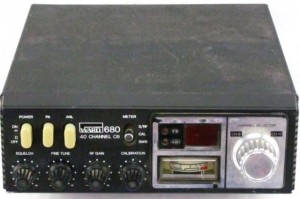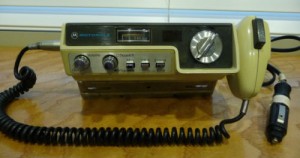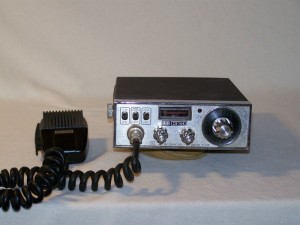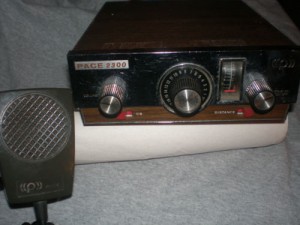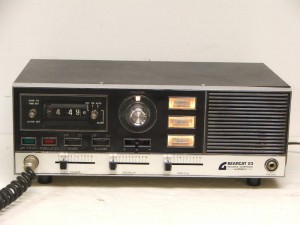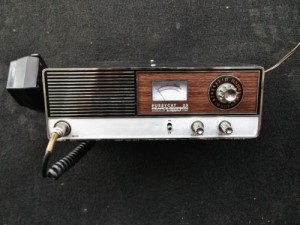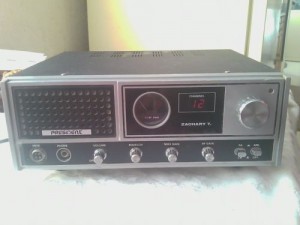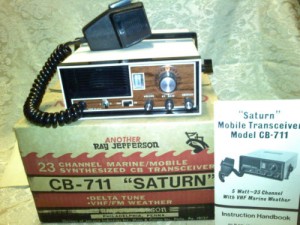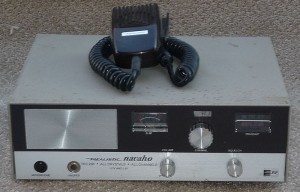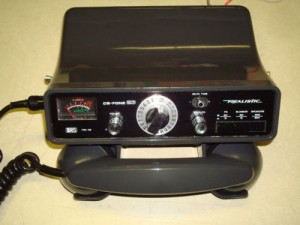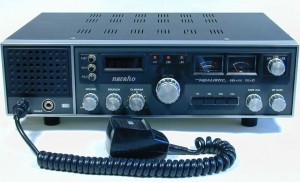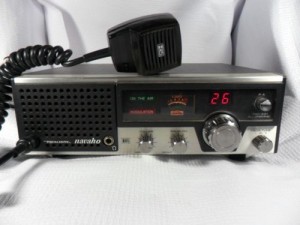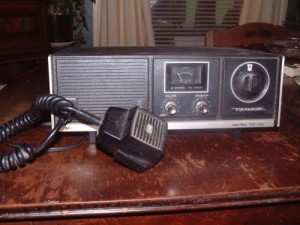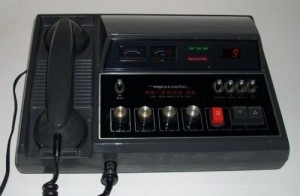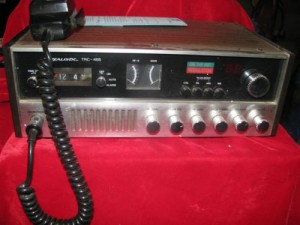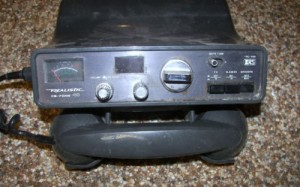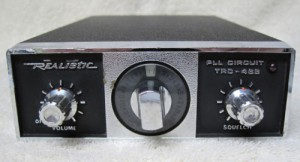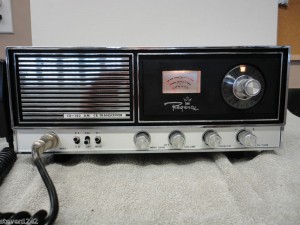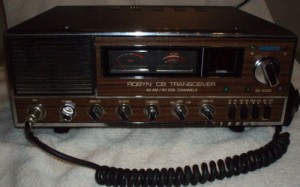In the 1970s and 80s, all 3 major retail store chains produced their own proprietary lines of CB radios. You could buy branded CB units from JCPenney, Montgomery Wards, and Sears. This Wards 680 is an attractive unit with 40-channel operation, RF gain, antenna warning (high SWR) indicator, and a large S/RF/SWR meter.
Motorola 4009 23 Channel AM Mobile CB Radio
Yes, Motorola made CB radios. They were very popular with police, fire, and emergency medical personnel. Reliable and rugged, as you would expect. Motorola CB units and microphones were purposely designed to match their commercial radio equipment of the day. Since most departments used Motorola gear for their VHF/UHF comms, it was a natural choice to choose a matching CB radio. The unit pictured here is the model 4009 23-channel mobile rig.
Pace CB144 23 Channel AM Mobile CB Radio
From the mid-1970s, here’s the Pace CB144 23-channel mobile. This was considered to be a mid-level unit in Pace’s model line. Features include delta tune, automatic noise limiter, noise blanker, and RF gain control. Standard red light on transmit and 4 pin female microphone connector. Performance was about average for the class.
Pace 2300 23 Channel AM Mobile CB Radio
Pace produced a full line of CB radios, both 23 and 40-channel models. This Pace 2300 mobile was manufactured in the early 1970s. A simple radio featuring volume, squelch, and a lighted meter. On the back of the radio, a large plastic modular jack marked ‘ACC PLUG’ allowed direct connection of various optional accessories.
Pearce-Simpson Bearcat 23 Channel AM Base CB Radio
Here’s a Pearce-Simpson Bearcat 23. This full-featured AM base station was popular in the mid-1970s. Note the unique 3-meter design and slide volume/squelch/SWR-CAL controls. Also featured a digital clock with alarm and separate lights for “on the air” (transmit) and modulation. There are 3 distinct versions of this radio: only the first version has slide pots. The ‘B’ version has regular knobs instead of the sliders. The ‘C’ version has only 2 meters. Also, the ‘A’ version has a black plastic face while the ‘B’ and ‘C’ use fake woodgrain. Pearce-Simpson CB radios were manufactured by the Gladding Corporation of Miami, Florida.
Pearce-Simpson Pussycat 23 Channel AM Base CB Radio
The Pussycat 23 was Pearce-Simpson’s entry-level 23 channel CB base station. Pearce-Simpson was a division of the Gladding Corporation. Just the basics here: volume, squelch, meter, channel selector, and microphone with standard 4 pin connector. This radio also featured a large S/RF meter and front-mounted speaker. Price for a new Pussycat 23 in 1974 was around $150.
President Zachary T 40 Channel AM Base CB Radio
In the spring of 1977, Uniden introduced a complete line of President 40-channel AM and SSB base and mobiles. I remember seeing the ads in S9, CB Times, and other CB magazines of the day. They were a pretty big deal. The Zachary T. was a basic but stylish AM base station. Basically a President Washington without sideband mode. Comparable in pricing and features to the Cobra 89XLR.
Ray Jefferson CB-711 Saturn 23 Channel AM Marine CB Radio
This rare unit is a Ray Jefferson CB-711 Saturn 23 channel marine CB radio. Built for use on boats and ships, it includes receive capability for VHF weather channels. At the time this radio was produced, there were only 2 NOAA weather frequencies: 162.400Mhz and 162.550Mhz. I’m guessing this is what the 2 position switch on the front of the radio is used for. You don’t see many of these around anymore.
Realistic Navaho TRC-23B 23 Channel AM Base CB Radio
The Realistic Navaho TRC-23B was Radio Shack’s most popular 23 channel CB base station. It featured great performance for the price which, in 1976, was just $159.99. Only the basic controls, but dressed up with a large “ON THE AIR / MODULATION” display which would light up on transmit. The TRC-23B also featured a strong front-mounted speaker, headphone jack, and 5-pin female DIN microphone jack.
Realistic TRC-56 23 Channel AM Mobile CB Radio
The Realistic TRC-56 was Radio Shack’s version of the “telephone” CB radio. It’s primary competitors were the Johnson Messenger 130/130A and the Midland 13-884. This Realistic CB-Fone 23 was a full-featured mobile unit with Delta Tune, noise blanker, and a large lighted S/RF meter. If the telephone handset wasn’t to your liking, you could replace it with a standard 5-pin DIN microphone.
Realistic Navaho TRC-57 40 Channel AM/SSB Base CB Radio
This Realistic Navaho TRC-57 was top dog in the late 1970s Radio Shack CB line. 40 AM channels, 40 upper sideband, and 40 lower sideband. Dual meters, digital clock, and a handy front-mounted headphones jack rounded out the attractive package. Retail price of this radio in 1978 was $399.99, but frequent sales brought the cost down to $329.99-349.99.
Realistic TRC-100B 6 Channel AM Walkie Talkie CB Radio
Radio Shack’s Realistic TRC-100B is a 5-watt, 6-channel CB walkie-talkie. Now you might be saying “How can a walkie-talkie put out 5 watts when the maximum legal CB power output is 4 watts?” This was a common ‘gain claim game’ played by manufacturers of CB walkie-talkies. This walkie-talkie has 5 watts RF INPUT to the final stage of the transmitter. The FCC limits CB transmitters to 4 watts RF OUTPUT from the final stage to the antenna. In a walkie-talkie, those 5 watts of input are much less once they pass through the finals. Certainly less than the 4 watt FCC maximum output for CB radios.
The ‘6 channel’ label is also somewhat misleading since this unit has 6 channel capability, but only comes with crystals for one channel installed. I believe it was Channel 11. If you wanted more channels, you had to buy additional crystals: one each for transmit and receive. Each pair of crystals to operate on an additional channel cost around $5. Doesn’t sound like much today, but it added up quickly in the mid-1970s.
Realistic Navaho TRC-431 40 Channel AM Base CB Radio
Radio Shack’s Realistic Navaho TRC-431 was the 40-channel replacement for their popular TRC-23B. This radio was simple but solid with good transmit audio and a sensitive receiver. Price in the late 1970s was $159.99, same as the 23 channel TRC-23B which it replaced. In my area, the TRC-431 was a popular base unit.
Radio Shack TRC-440 40 Channel AM Base CB Radio
The Realistic Navaho TRC-440 was Radio Shack’s entry-level 40-channel base station. This is a very simple radio with volume, squelch, rotary analog channel selector, and an S/RF meter. List price in the catalog was $139.99, but frequent sales brought it down to $99.99. As with many other Realistic Navahos, a front-mounted headphone jack and 5-pin DIN female microphone jack round out the package.
Realistic TRC-454 40 Channel AM Base CB Radio
Radio Shack also made a base station version of the CB-Fone, although it was less popular than their mobile versions. The Realistic TRC-454 was a full-featured AM base station with large dual S/RF and SWR/CAL meters and instant Channel 9 emergency access. Unlike the Johnson Messenger and some other “telephone CBs”, the handset on the TRC-456 is detachable and terminates in a standard 5-pin DIN plug. This way, if you want to use a regular hand mic or desk mic, you’re able to do so without having to internally rewire the radio.
Realistic Navaho TRC-455 40 Channel AM Base CB Radio
Realistic’s Navaho TRC-455 was Radio Shack’s top-of-the-line 40 channel AM base station in the late 1970s. This one had all the bells and whistles, including digital clock with alarm. If you wanted to hear your CB buddies first thing every morning, the TRC-455 could wake you up to the sounds of your favorite channel! Price in 1977 was $229.99.
Realistic TRC-456 40 Channel AM Mobile CB Radio
When the FCC made 40 channel CB radios legal in January, 1977, Radio Shack replaced their TRC-56 “CB Fone” with the Realistic TRC-456. Appearance is very similar to its predecessor, adding 17 more channels and a digital frequency readout. Performance is adequate, though transmit audio quality suffers due to a telephone handset being used as a microphone.
Realistic TRC-468 40 Channel AM Mobile CB Radio
Another of Radio Shack’s very basic but popular CB radio was the Realistic TRC-468. This model featured all 40 channels, but no frills. Not even a digital channel display or a S/RF meter. Regular price was $99.99, but frequent sales brought it down to $69.99-79.99. Introduced in 1977, this was the 40 channel replacement for Realistic’s TRC-68 “Mini 23.”
Regency CR-142 23 Channel AM Base CB Radio
Here’s a Regency CR-142 AM base station. This simple but effective CB radio features all 23 channels, delta tune, automatic noise limiter, adjustable mic gain, and a large meter which measures S/RF and modulation. A front panel switch selects reading for RF output or modulation on transmit. Also included is a mike gain control, usually not found on lower end transceivers.
Robyn SB-520D 40 Channel AM/SSB Base CB Radio
This stylish 40 channel base station is a Robyn SB-520D. The “SB” stands for sideband: LSB, USB, and AM are all featured on this radio. Plus large dual S/RF and SWR meters plus all the extras you would expect from a top-of-the-line unit. I have seen 2 versions of the 520D. The one pictured has a fake woodgrain faceplate. The other has a black plastic faceplate. Otherwise, these radios are identical.
